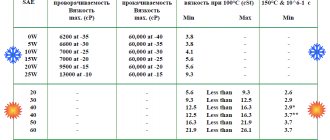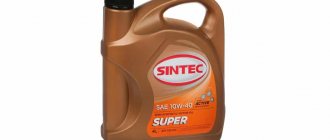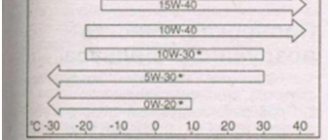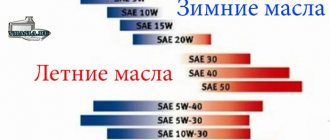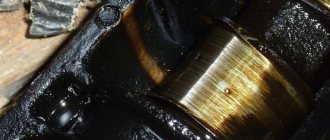What is oil viscosity? This is one of the key quality indicators common to all types of oils. It is responsible for the thickness of the oil and can change significantly depending on the temperature. Therefore, it is very important that the oil has sufficient viscosity to ensure lubrication of rubbing parts and mechanisms over a wide temperature range.
In this article, we will explain in simple and understandable language what oil viscosity is, how it changes depending on temperature, what parameters it affects, and what the numbers mean in the SAE oil viscosity designation.
What is oil viscosity according to SAE
The SAE designation is usually deciphered as the applicability of the oil to the temperature outside, which is inherent in a particular region. This statement is true, but only partially, and only applies to the SAE low temperature index.
What do these numbers in oil mean? For example, viscosity 5W-40 denotes an all-season oil, as indicated by its double index and the letter W. Most oils on the market are all-season types; the days of oils with a single index are long gone, with the exception of oils for various mechanisms, chainsaws , cultivators, etc.
5W here indicates the low-temperature properties of the oil: at what temperature it will not lose its fluidity, will ensure safe cranking and engine starting in cold weather, and will freeze completely, making pumping through the channels impossible. You can partly rely on this index when choosing oil for winter, but you still need to look at the indicators of the specific brand chosen, since they can vary greatly.
Index 40 in our example shows the high-temperature properties of the oil. Most drivers take it as the air temperature outside the engine at which oil can be used in the summer, but this is not true. The oil in the engine warms up to 100 degrees, and the air temperature does not affect its quality. This index indicates the high-temperature viscosity of the oil at a temperature of 100 degrees. This is no less important an indicator than the winter index, as it indicates the thickness of the oil film and the ability of the oil to be pumped through channels of different thicknesses. Each engine has its own characteristics, and it is important to select the oil viscosity from those recommended by the manufacturer.
To decipher SAE viscosity, the following tables are accepted:
But, as I said above, these figures are only partially correct and only in relation to the low-temperature index. For high-temperature viscosity, it is more correct to consider the table of kinematic viscosity at 100 degrees, and for low-temperature dynamic viscosity, we will consider them further.
Designation of motor oils according to the API standard
The API (American Petroleum Institute) standard specifies where the oil should be used. Consists of two Latin letters. The first letter S is a gasoline engine, C is a diesel engine. The second letter is the date of development of the car.
Gasoline engines:
- SC - cars that were produced before 1964;
- SD - cars that were produced 1964-1968;
- SE - copies that were produced in 1969-1972;
- SF - cars that were produced in the period 1973-1988;
- SG - cars developed in 1989-1994 for use in harsh conditions;
- SH - cars developed in 1995-1996 for harsh operating conditions;
- SJ - copies with a production date of 1997-2000, which have the best energy saving;
- SL - cars, with the beginning of production 2001-2003, and having an extended service life;
- SM - cars produced since 2004;
- SL+increased oxidation resistance.
For diesel engines:
- CB - cars manufactured before 1961, high sulfur content in fuel;
- CC - cars manufactured before 1983, operating in difficult conditions;
- CD - cars produced before 1990, which had to work in difficult conditions and a large amount of sulfur in the fuel;
- CE - cars manufactured before 1990 and the engine has a turbine;
- CF - cars produced since 1990, with a turbine;
- CG-4 - copies produced since 1994, with a turbine;
- CH-4 - cars manufactured in 1998, complying with toxicity standards applied in the USA;
- CI-4 - turbocharged cars with EGR valve;
- CI-4 plus - similar to the previous one, under high US toxicity standards.
Oil viscosity index
These mysterious numbers on the canister - the viscosity index - are not taken into account by every car owner. This is an empirical, dimensionless indicator; it is used to evaluate the dependence of oil viscosity on temperature changes. The higher the viscosity index, the less the oil will react to temperature changes.
If the oil has a high viscosity index, it will thicken less in cold weather, that is, during a cold start, and will remain thicker when warmed up to operating temperatures. The viscosity index depends on the molecular structure of the compounds that make up the base of the oil. The purer the mineral base, the higher its index will be. The highest indices are for synthetics and hydrocracking.
To calculate the viscosity index of an oil, its actual kinematic viscosity at 40 and 100 degrees is used. This data is driven into a simple formula created from empirical calculations derived from two reference lubricants.
Most modern oils have an index from 140 to 180 units. There are categories of Japanese oils with low viscosity, where the index crosses the line of 200 units. These oils are created on the basis of technological bases - polyalphaolefins, esters with the addition of special additives.
It is difficult to say which viscosity index is better. The one that is higher is always better, as it shows that the oil can adapt well to temperature overloads, but at the same time, each category of SAE oils has its own index limit, it also depends on the composition; synthetic oils will always be higher.
For example, for traditional synthetic and semi-synthetic oils SAE 10W-40, the normal index is 150-160 units. For oils with a lower viscosity 5W-30 it is higher – 160-180. Low-viscosity materials will have an index of up to 240 units. And the newest ultra-low-viscosity oils of class 0W-16 or 0W-10 may have an even higher index, but such oils cannot be found on sale, since their scope of application is very narrow and does not apply to ordinary cars.
Engine oil viscosity at operating temperatures
After the engine has warmed up, the cooling system is activated. One engine cycle looks like this:
- Pressing the gas pedal increases the engine speed and increases the load on it, as a result of which the friction force of the parts increases (since the too astringent liquid has not yet had time to get into the gaps between parts),
- the oil temperature rises,
- the degree of its viscosity decreases (fluidity increases),
- the thickness of the oil layer decreases (leaks into the gaps between parts),
- friction force decreases,
- The oil film temperature is reduced (partially with the help of the cooling system).
Any motor system works on this principle.
Viscosity of motor oils at a temperature of - 20 degrees
The dependence of oil viscosity on operating temperature is obvious. Just as it is obvious that the high level of motor protection should not decrease throughout the entire period of operation. The slightest deviation from the norm can lead to the disappearance of the motor film, which in turn will negatively affect the “defenseless” part.
Each internal combustion engine, although it has a similar design, has a unique set of consumer properties: power, efficiency, environmental friendliness and torque. These differences are explained by the difference in engine clearances and operating temperatures.
In order to select the oil for a vehicle as accurately as possible, international classifications of motor fluids have been developed.
The classification provided for by the SAE standard informs car owners about the average operating temperature range. API, ACEA, etc. classifications give a clearer idea of the possibility of using lubricant in certain vehicles.
Kinematic and dynamic oil viscosity
Exactly the indicators that I spoke about at the beginning of the article. The established SAE viscosity depends on them, the very numbers that the manufacturer indicates on the canister.
Kinematic viscosity shows the fluidity of the oil at a temperature of 40 degrees and 100. It is measured by a capillary viscometer - the flow time of the liquid at a certain temperature is determined. Denoted by mm2/s.
Dynamic viscosity is also measured experimentally. It shows the resistance force of the oil fluid that occurs during the movement of two layers of oil, spaced 1 cm apart and moving at a speed of 1 cm/s. This value is measured in Pascal seconds. As can be seen from the table above, the temperature for determining dynamic viscosity is different for different oil viscosities.
What does dynamic and kinematic viscosity mean?
Kinematic viscosity is two indicators within which an oil must be in order to belong to one or another SAE category. Dynamic viscosity shows at what temperature the oil will ensure safe engine starting. The lower the actual value from the accepted upper barrier, the lower the temperature at which it is possible to safely start the engine with the specified oil.
For example, 10W oil at -25 degrees should have a dynamic viscosity of no more than 7000. That is, if the actual oil indicator is almost equal to 7000, it is no longer recommended to start the engine at -25, it is better to do it no lower than -20. But if there is an oil with a dynamic viscosity of 6500, then it is already applicable at -25, 6000 - below -25, and so on.
What is worse - low or high viscosity?
What will happen if, when the engine warms up at a low temperature, the oil viscosity is higher than normal? The friction force will increase. As a result, the engine temperature will begin to increase and will stop only when the viscosity drops to the required level (and, therefore, the friction force decreases). On the one hand, nothing bad will happen, but the engine will operate at a higher temperature not calculated by the manufacturers. And this can have a bad effect on its service life - parts will wear out faster. That is, the likelihood of engine failure increases. In addition, the engine fluid will have to be changed more often, since due to the high temperature it will be used up faster.
It is much worse and more dangerous when the viscosity of the lubricant is lower than required. As a result, lubricant consumption will increase significantly, and there is also a possibility that the engine will simply jam at high speeds. That is why it is strongly recommended to choose motor fluids that have the approval of the car manufacturer.
Which viscosity is best for the engine?
To understand why we cannot use the oil viscosity that we prefer or seems more suitable, we need to understand how viscosity affects engine performance. For example, there are a number of low-viscosity sports oils, but if we pour one of them into a regular engine, it will not become sportier and faster, but, on the contrary, will quickly lose power and simply “die.”
The viscosity of the oil is selected based on its design, recommended by the manufacturer, and it is impossible to go beyond the recommended limits. Engine parts have different clearances, new engine models are designed to save fuel and oil, the gaps between parts are minimal, such engines require low-viscosity oils, but if you fill in thicker ones, the moving elements will work under load and constantly overheat, which over time will lead to a number of unpleasant problems.
Older engine designs have large gaps between parts; this is provided for both by the design itself and by the development that appears over time. Such engines require thicker oils; if you fill in less thick ones, the film formed will not be thick enough and will break at the contact points, which will lead to rapid wear of parts.
Oil viscosity cannot be better or worse; it may simply be suitable for each specific engine. In the service book you will find recommendations for at least two suitable viscosities for your engine, and it is between them that you need to choose. And don’t forget about API and ACEA classes, as well as approvals from manufacturers.
What is oil used for?
Automotive oil ensures the proper functioning of various systems. It is used to reduce friction, cool, lubricate, transfer pressure to vehicle parts and components, and remove combustion products. The most difficult operating conditions occur with motor oils. They must not lose their properties in the event of instantaneous changes in thermal and mechanical loads, under the influence of atmospheric oxygen and aggressive substances resulting from incomplete combustion of fuel.
The oil creates an oil film on the surface of rubbing parts and reduces wear, protects against rust, and reduces the impact of chemically active components that arise during engine operation. By circulating in the engine crankcase, the oil provides heat removal, removes wear products (metal chips) from the contact zone of rubbing parts, and seals the gaps between the cylinder walls and piston group parts.
SAE classification
In accordance with the SAE class, any motor oil has low and high temperature viscosity. There are no only winter or only summer oils, there are simply different viscosity indicators. But since our compatriots are accustomed to this interpretation, we will use it.
Engine oil viscosity table
Classification of lubricants according to the SAE standard according to air temperature
Table of fluid parameters for different viscosity characteristics
Winter oils
For example, we take a petroleum product with the index 5W30. To correctly calculate the operating parameters, the number 40 is subtracted from the number preceding the W index (this is a constant). The result is the air temperature at which the consumable can be used. To determine the cranking temperature of the power unit, the number 35 is subtracted from the index.
The use of low temperature consumables is recommended at the following values:
- 0W. The lubricant will retain its characteristics at sub-zero temperatures in the range from -30 to -35 degrees.
- 5W. The petroleum product will ensure high-quality starting of the machine’s engine and pumping of lubricant through the system channels in the range from -25 to -30 degrees.
- 10W. The type of lubricant with index 10W will ensure a high-quality start of the internal combustion engine in the range from -20 to -25 degrees.
- 15W. The lubricant will maintain operating parameters at low temperatures in the range from -15 to -20 degrees.
- 20W. Operational parameters and characteristics are saved in the range from -10 to -15 degrees.
It is important that the viscosity parameter corresponds to the pumpability and crankability values.
Summer oils
In accordance with the international classification, summer lubricants are designated exclusively by numbers, for example, SAE 40. This number in the viscosity of the engine oil determines the average value, which determines the operating parameter when the substance operates at high temperatures.
Viscosity table for summer oil products
All-season oils
All-season working fluids can be used at any air temperature. The viscosity parameter will change taking into account the temperature regime, which will ensure high-quality lubrication of the components of the internal combustion engine system. Petroleum products intended for all seasons correspond to the parameters of the highest rotational viscosity at low temperatures and the lowest at elevated temperatures.
Types of oils depending on temperature conditions
The viscosity of lubricants may vary under different conditions. It is directly dependent on the ambient temperature, the speed of heating of the mechanisms, and the operating mode of the engine. At low temperatures, the viscosity should not be too high to ensure starting the vehicle in cold weather. In high temperature environments, on the contrary, the lubricant helps to ensure proper pressure and creates a protective layer between the surfaces that are in contact.
Based on viscosity, lubricants are divided into winter, summer and all-season. All-season products are more convenient. It is more energy efficient, and such oils do not need to be changed as often as materials for a certain season.
Basic viscosity parameters
When analyzing the information that manufacturers declare on product labels, each buyer should distinguish between concepts such as kinematic and dynamic viscosity. They differ in density, units and methods of measurement and are used to measure different classes of lubricants.
Kinematic viscosity indicates such a property of the oil as its fluidity. It is determined at normal and maximum operating temperatures. Typically, modes such as forty and one hundred degrees Celsius are chosen for testing. This value is measured in centistokes.
Based on kinematic viscosity indicators, the viscosity index of the motor oil is calculated. If you want to choose the truly best lubricant, the index should be more than 200; all-season oils usually have it.
Dynamic viscosity characterizes the resistance force when liquids move relative to each other, regardless of density. The unit of measurement is centipoise.
How not to make a mistake in choosing oil
When choosing consumables, it is best, of course, to follow the manufacturer's recommendations. When producing a car in laboratory conditions, a viscosity index is calculated that optimally corresponds to the operating parameters of a particular power unit.
Agree, it is unlikely that the viscosity of turbine oil will be suitable instead of the viscosity specified for a passenger car. If the car's mileage has exceeded half of its planned life, then it should be filled with a higher viscosity index.
In any case, for proper distribution of lubricant between contacting parts, anti-corrosion protection, and cooling, selection will have to be made based on:
- Weather temperatures of a specific region;
- Engine operating parameters;
- Suitable viscosity grade;
- The degree of wear of internal components and parts;
- Features of the structure of power units.
In conclusion, I would like to say that lubricating fluids for cars are the same as blood in human veins: the health and functioning of the entire “organism” depends on both the thickness of the blood in the human body and the viscosity of the oil in the car.
